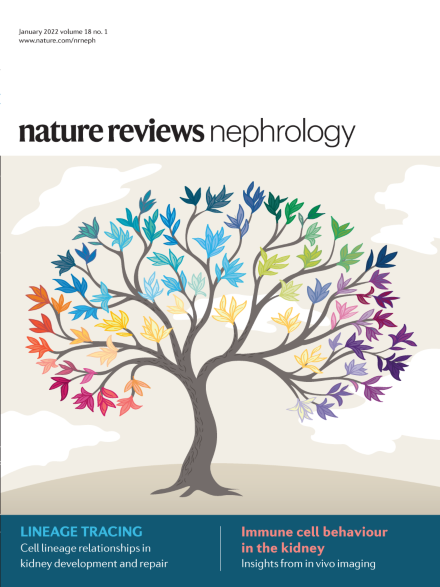Roles of sensory receptors in non-sensory organs: the kidney and beyond
IF 39.8
1区 医学
Q1 UROLOGY & NEPHROLOGY
引用次数: 0
Abstract
Olfactory receptors (ORs), taste receptors and opsins are well-known for their pivotal roles in mediating the senses of smell, taste and sight, respectively. However, in the past two decades, research has shown that these sensory receptors also regulate physiological processes in a variety of non-sensory tissues. Although ORs, taste receptors and opsins have all been shown to have physiological roles beyond their traditional locations, most work in the kidney has focused on ORs. To date, renal ORs have been shown to have roles in blood pressure regulation (OLFR78 and OLFR558) and glucose homeostasis (OLFR1393). However, sensory receptors remain drastically understudied outside of traditional sensory systems, in part because of inherent challenges in studying these receptors. Increased knowledge of the physiological and pathophysiological roles of sensory receptors has the potential to substantially improve understanding of the function of numerous organs and systems, including the kidney. In addition, most sensory receptors are G protein-coupled receptors, which are considered to be the most druggable class of proteins, and thus could potentially be exploited as future therapeutic targets. Sensory receptors in non-sensory organs respond to chemical stimuli, initiate signalling cascades and have important roles in cell biology and physiology. Here, the authors discuss key examples of sensory receptors with physiological roles in the kidney and other tissues.


感觉受体在非感觉器官中的作用:肾脏及其他
嗅觉受体(ORs)、味觉受体和视蛋白分别在嗅觉、味觉和视觉的调节中发挥着关键作用。然而,在过去的二十年中,研究表明,这些感觉受体也调节各种非感觉组织的生理过程。虽然ORs,味觉受体和视蛋白都被证明具有超越其传统位置的生理作用,但肾脏中的大多数工作都集中在ORs上。迄今为止,肾脏ORs已被证明在血压调节(OLFR78和OLFR558)和葡萄糖稳态(OLFR1393)中发挥作用。然而,在传统的感觉系统之外,感觉受体仍然没有得到充分的研究,部分原因是研究这些受体存在固有的挑战。增加对感觉受体的生理和病理生理作用的了解,有可能大大提高对包括肾脏在内的许多器官和系统功能的理解。此外,大多数感觉受体是G蛋白偶联受体,这被认为是最具药物性的一类蛋白质,因此可能被开发为未来的治疗靶点。
本文章由计算机程序翻译,如有差异,请以英文原文为准。
求助全文
约1分钟内获得全文
求助全文
来源期刊

Nature Reviews Nephrology
医学-泌尿学与肾脏学
CiteScore
39.00
自引率
1.20%
发文量
127
审稿时长
6-12 weeks
期刊介绍:
Nature Reviews Nephrology aims to be the premier source of reviews and commentaries for the scientific communities it serves.
It strives to publish authoritative, accessible articles.
Articles are enhanced with clearly understandable figures, tables, and other display items.
Nature Reviews Nephrology publishes Research Highlights, News & Views, Comments, Reviews, Perspectives, and Consensus Statements.
The content is relevant to nephrologists and basic science researchers.
The broad scope of the journal ensures that the work reaches the widest possible audience.
 求助内容:
求助内容: 应助结果提醒方式:
应助结果提醒方式:


